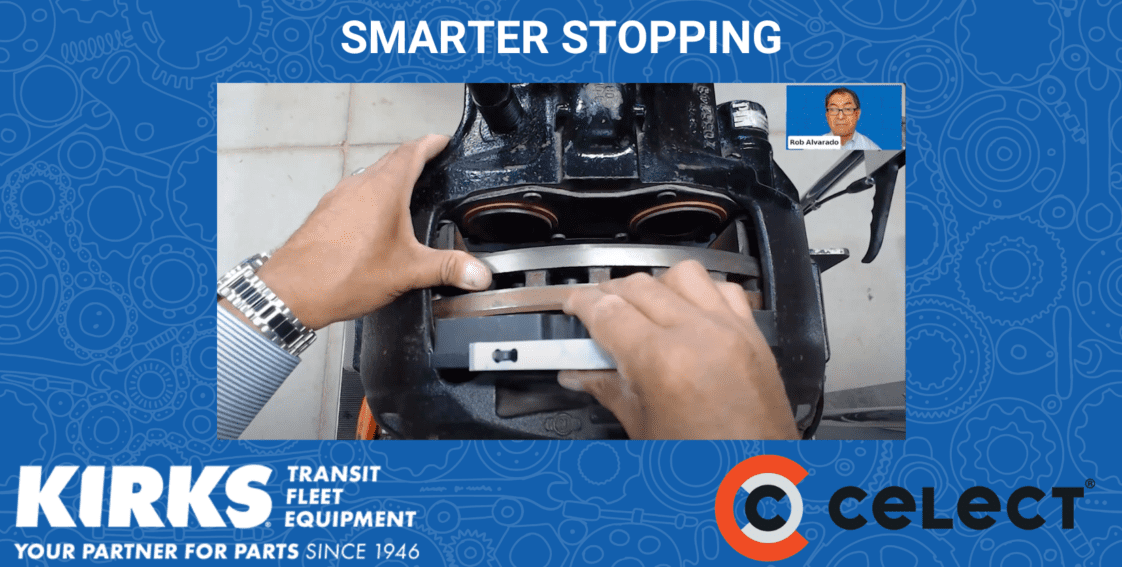
Smarter Stopping: KIRKS ToolBOX Has Expert Tips for Maintaining Heavy-duty ADB Systems
Tips for Maintaining ADB Systems
- Heavy-duty ADB Brake SpecialistBOX
- Differences in Heavy-Duty Brake Systems
- ADB vs. Drum Brakes
- Red Flags for Failure of Heavy-duty ADB Systems
- Heavy-duty ADB Replacement Parts
- Keep Your ADB System in Top Shape
According to a Federal Motor Carrier Safety Administration study, braking problems accounted for nearly 30 percent of large truck accidents. In Michigan, a 2021 study showed that vehicle brake problems caused 29% of the 15,000 crashes involving large trucks or buses. Proper maintenance of our heavy-duty ADB (Air Disc Brake) systems is vital to critical stopping power.
Federal law already imposes strict regulations for the maintenance and upkeep of commercial trucks and bus brakes. What more is needed?
Heavy-duty ADB Brake Specialist Covers Maintenance on KIRKS ToolBOX
As part of KIRKS’ ongoing ToolBOX webinar series for the transit and fleet industries, Bob Kirkman met with Rob Alvarado, North American Technical Sales Manager for Celerity Systems, Inc. Rob has done multiple trainings with the KIRKS team, and Bob wanted to bring him on the ToolBOX to share his knowledge with technicians in the transit, coach, and fleet industries.
With over 30 years in the automotive parts business, Rob Alvarado knows brakes and brings valuable advice for preventing and resolving ADB issues.
Rob’s presentation focused on air disc brakes and the importance of regular preventative maintenance, the key to bringing down failure rates and improving performance.
Differences in Heavy-Duty Brake Systems: an ADB and Drum Overview
Passenger vehicles have hydraulic brakes, while commercial vehicles, including tractor-trailers, have pneumatic or air brakes. Air brakes operate using two technologies: drum or disc.
- With drum brakes, also called “foundation” brakes, pressing the brake pedal causes pressure in the brake cylinder to push the cam. The cam brings up rollers that push the brake shoe against the drum. The friction slows the wheel. When the brake pedal is released, the shoe is pulled by springs back into place, releasing the wheel. The shoe’s return rotates the cam to its original position.
- Air Disc Brakes (ADB) are different. The brake pedal directs air from the compressor’s reservoir via lines and valves to the brake cylinder. In the brake chamber, pressure builds to move the caliper on the guide pins, actuating a bridge to contact the brake pad and rotor. This contact creates friction to decelerate wheel rotation.
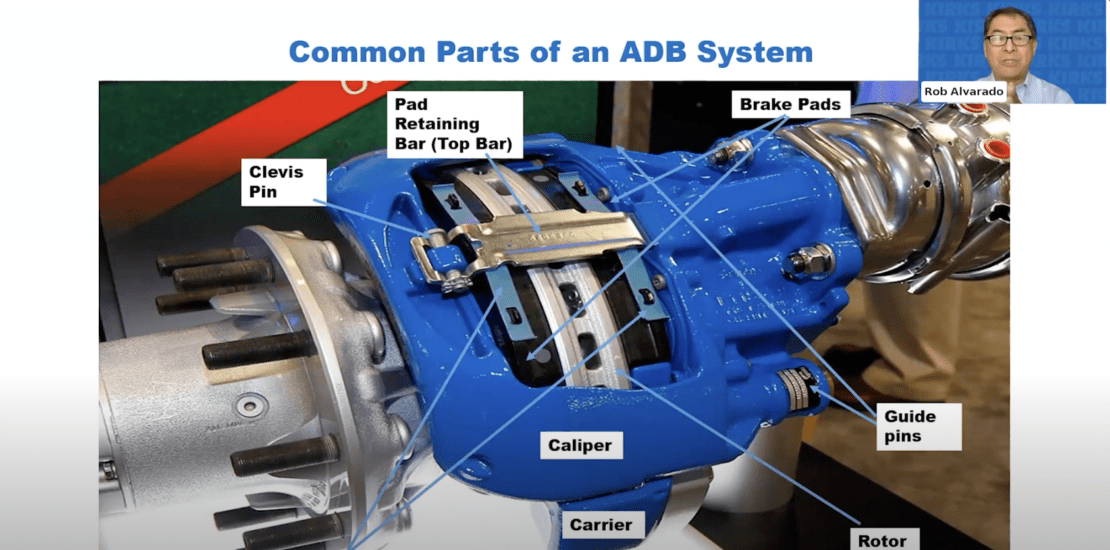
In our discussion, available on YouTube, Alvarado noted the growing popularity of ADB systems over drum brakes. He explained the intricacies of these systems, including typical parts, how they operate, and the offerings from top manufacturers.
Biggest Advantages of ADB Over Drum Brakes
Twelve years ago, the National Highway Traffic Safety Administration (NHTSA) issued stringent new braking standards that have helped to save lives by improving large truck-stopping distances. Alvarado said, “This change helped to make air disc braking systems very popular.” He continued, “A fully loaded Class 8 tractor-trailer going 60 miles per hour can stop in only 250 feet instead of 355 feet, about a third less space.”
Beyond shorter stopping distances, Alvarado provided several reasons for ADB on buses and tractor-trailers. These included ease of maintenance, fewer brake changes, and less downtime.
Why Air Disc over Drum Brakes
| Better Performance | Shorter Stopping Distances (FMVSS121<250′) |
| Better Efficiency | Clamping (rotors) vs. Pushing Outward (drum) |
| Reduced Brake Fade | Safer Stops in Emergency Situations |
| Easy Maintenance/Replacement | Less Time in Shop, Saves Money |
| Longer Brake Changes Cycles | More miles on the road, Saves Money |
| Pads Will Not Freeze to Rotors | Less “Truck Down” Issues |
| Calipers are Enclosed | No Roadside “Out of Stroke” Issues |
Red Flags for Failure of Heavy-duty ADB Systems
Alvarado provided many tips for identifying early signs of trouble. We’ve highlighted a few from the webinar (you can watch the full replay here):
- Overheated Brakes – Technicians should inspect for any signs of thermal overload. They can easily identify this condition from the red powder residue caused by excessive heat.
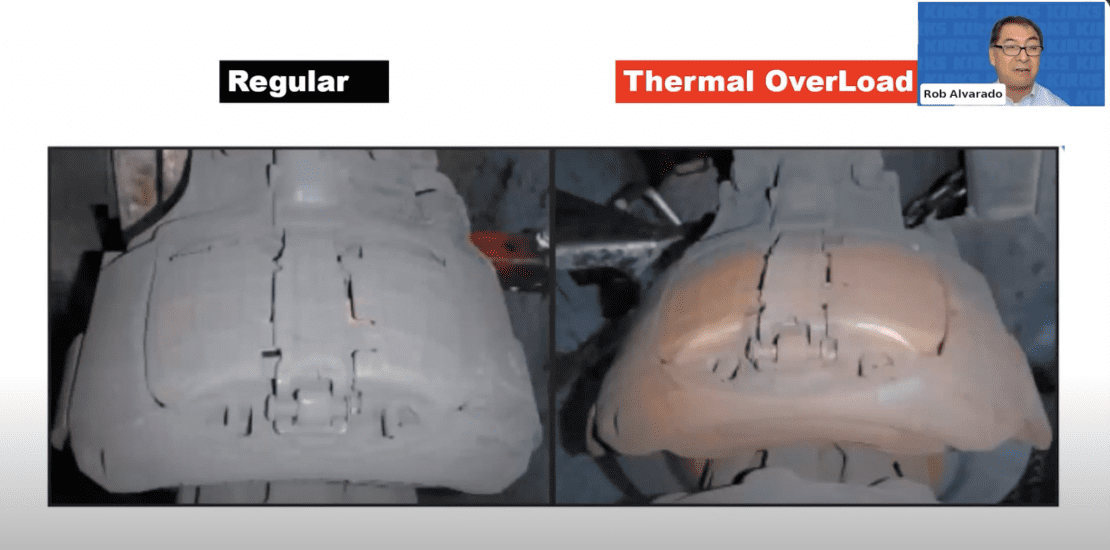
- Brake Pad Damage – Inspect for cracked edges or surface gouging.
- Uneven Brake Pad Wear – Remove both brake pads, place them next to each other, and “eyeball” their thickness to identify the inside and outside variances. Alvarado uses a micrometer to ensure the inside and outside distances are within specification. Excessive distances may signal a need for servicing the caliper.
“Ease your maintenance time and change the brake pads. It’s about 60 to 75% less time than changing shoes on Foundation brakes. Once you’ve changed them, they have longer intervals between changing the pads or linings versus Foundation brakes.”
– Rod Alvarado, North American Technical Sales Manager for Celerity Systems
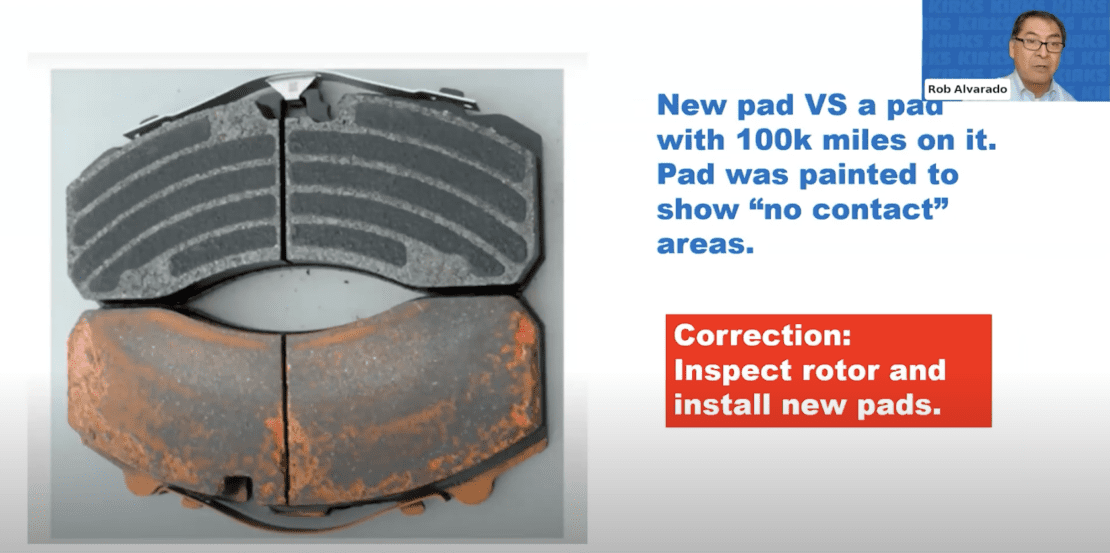
Remaining Brake Pad Life – Pay particular attention to the wear indicators, which prevent failures by telling when to replace brake pads. Rob showed several examples, including rubber bush-bearing variants, open-bearing models, and short or long rubber sleeves. Wireless rotation measurement sensors automatically inform technicians when maintenance is due on newer products.
OE-Authorized Brake Pad Change Demonstration
Rob’s demonstration of performing an OE-authorized ADB22X Bendix brake pad change included required testing procedures to ensure safe and efficient vehicle operation. No specialty tools were needed.
He had practical tips on evaluating brake pad wear, tappet boot tears or wearing, and important guidelines he teaches in all his training classes.
Even seasoned technicians will find value in watching Rob’s step-by-step ADB system brake pad change demonstration. Watch it here.
- Tappet and Boot Damage – Rob discussed the differences between the dual and single tappet caliper systems. He stressed the need for the boots protecting the brake system to be intact. If compromised, this can lead to issues such as brake fade or a fire. He explained, “The weakest part of all calipers are the rubber boots, so once these boots get torn, contamination gets into the two different systems.”
During Rob’s demonstration, he showed how to inspect them thoroughly and that they should be checked during every brake preventative maintenance job.
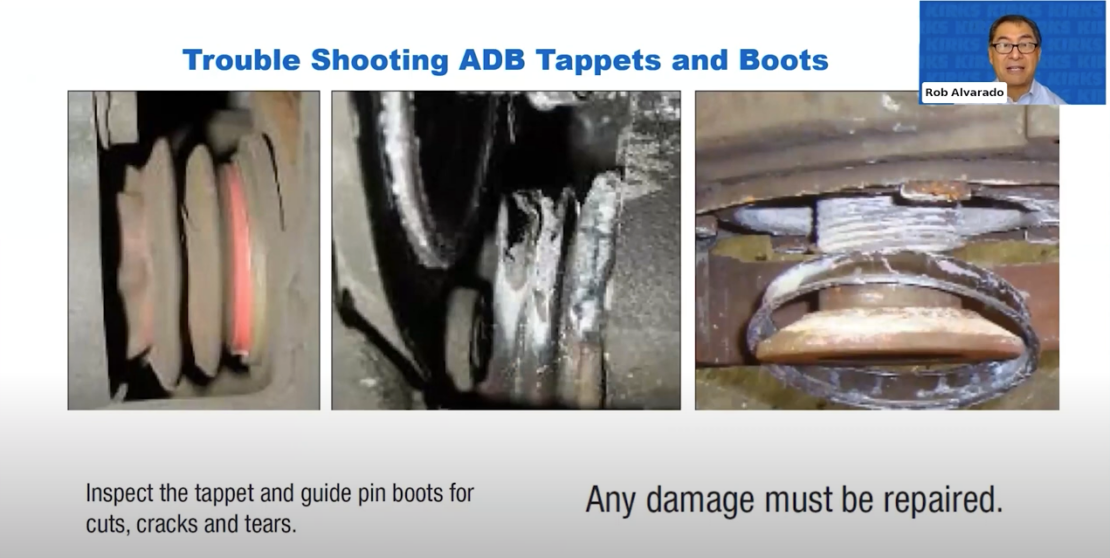
- Running Clearance – Using a feeler gauge, Rob explained how to measure running clearance, a vital part of maintaining performance.
- Chain Protection – When reinstalling the shear adapter, Rob stressed the importance of protecting the chain in the Knorr Bremse and Bendix calipers. These synchronize the two drivers inside the tubes, called tappets. Rob cautioned viewers that too much pressure on the ratchet breaks the chain. “If you break that chain, the caliper is no good.”
- Tension Springs – On top of the brake pads are 2 tension springs. These provide tension by means of the pad retaining bar. “Every time you change brake pads every single manufacturer says to replace those, and it’s there for a reason. Each manufacturer has a different way that they attach the top bar,” Rob noted, “On the Knorr-Bremse/Bendix, it’s a clevis pin, on the Meritor, it’s a washer and a cotter pin.”
Selecting the Right Heavy-duty ADB Replacement Parts
Alvarado discussed the pros and cons of several brake system manufacturers. For example, he explained that the Knorr Bremse SB/SN7000 models required fewer maintenance inspections due to fewer parts than the sturdier Meritor EX225 H2 and H3 models.
When replacing brake components, technicians will want to consider the benefits of Celect air disc pads and rotors. We discussed these products in KIRKS’ April 2023 Spotlight on Celect. Their brake rotors are OE quality, with high braking performance and outstanding wear. They are mill-balanced, ECE R90 Certified, and exceed Federal MVSS No. 121 standards.
Celect Copper-Free Brake Pads will perform with outstanding wear characteristics required by the Better Braking Law 2025 and will maintain high global advanced braking technology standards.
You’ve ‘Got What it Brakes’ to Keep Your ADB System in Top Shape
Diagnosing brake failure can be a daunting task. Rob assists fleet managers in analyzing the complete system and each part to find telltale signs pointing toward the root cause.
KIRKS ToolBOX connects experts like Rob Alvarado with your technical maintenance squad for personal training. Bob Kirkman stresses the need for professional training. Contact KIRKS and one of our account managers will set up a training session at your location. Combining training with reliable parts will reduce the high incidence of brake system failures and keep your vehicles moving—and stopping—safely.
About CELECT by Celerity Systems
Celerity Systems is part of the Bremsen Technik Group and manufactures Celect products. Celect provides rotors, brake pads, and drum brake linings to equipment manufacturers and aftermarket distributors internationally.
Kirks Provides Celect Brake Pads and Rotors
KIRKS has been your partner for parts, providing complete braking solutions for every industry: automotive, heavy-duty truck, industrial equipment, and transit.
Escape the parts trap! KIRKS product specialists will help you navigate the parts maze. Contact us today.
